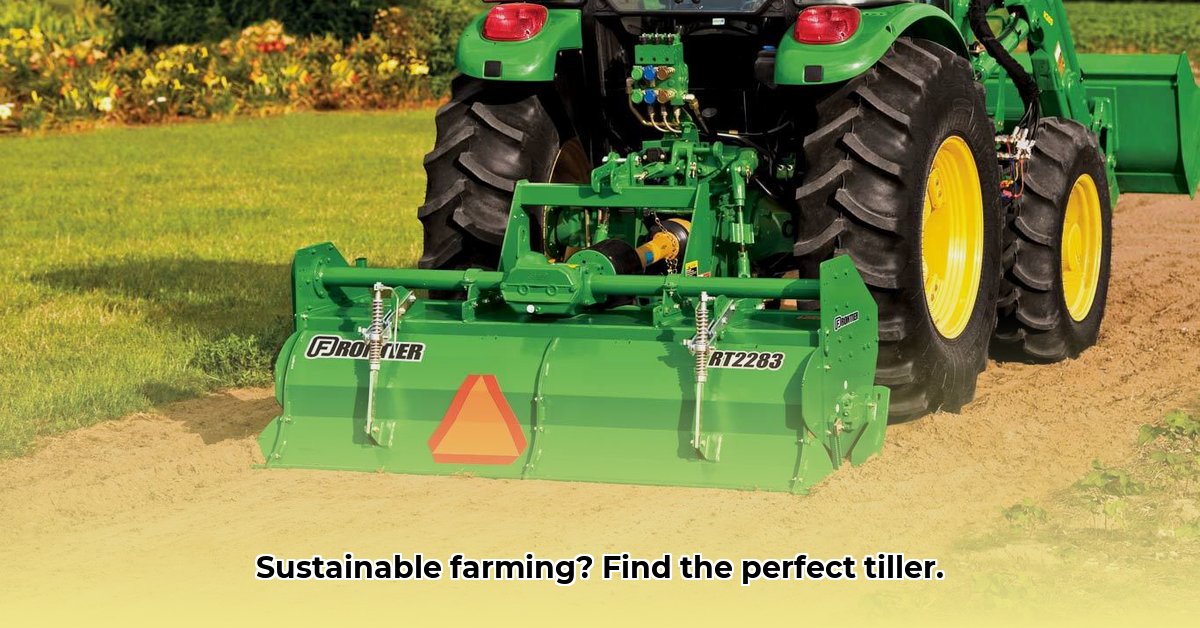
Sustainable farming hinges on healthy soil, and choosing the right compact tractor tiller is a crucial step in achieving that goal. This guide provides a comprehensive approach to selecting and utilizing a tiller for environmentally conscious agriculture. We'll examine different tiller types, explore sustainable tilling techniques, and delve into alternative soil preparation methods. This will empower you to make informed decisions that benefit both your farm and the environment. For more tiller options, check out this helpful resource.
Understanding Rotary Tillers and Sustainable Agriculture
Rotary tillers, or rototillers, are machines designed to break up soil, creating a seedbed suitable for planting. While offering benefits like weed control and improved aeration, excessive tilling can damage soil structure, leading to decreased water retention and nutrient loss. This is particularly crucial in sustainable agriculture, where soil health is paramount. Therefore, the responsible use of a rotary tiller requires a balance between its advantages and the potential for negative environmental impact. How can we optimize this balance?
Types of Compact Tractor Tillers: Gear-Driven vs. Belt-Driven
Two primary types of compact tractor tillers exist: gear-driven and belt-driven. Gear-driven tillers are known for their robustness and power, making them ideal for heavy, compacted soils. However, they tend to be less fuel-efficient and less maneuverable. Belt-driven tillers, conversely, are lighter, more fuel-efficient, and easier to maneuver, making them better suited for smaller farms or fields with diverse crops and lighter soils.
| Feature | Gear-Driven Tiller | Belt-Driven Tiller |
|---|---|---|
| Power | High; suitable for heavy, compacted soils | Moderate; ideal for lighter soils |
| Durability | High; longer lifespan | Moderate; potentially shorter lifespan |
| Maneuverability | Lower; better for large, open fields | Higher; good for smaller fields & varied crops |
| Fuel Efficiency | Lower | Higher |
| Soil Type | Heavy clay, rocky soils | Lighter, less compacted soils |
| Cost | Typically higher | Typically lower |
Which type is right for your farm? Consider your soil type, farm size, and budget when making your selection.
Choosing Your Compact Tractor Tiller: A Practical Approach
Selecting the right tiller involves careful consideration of several key factors. This process can be broken down into five actionable steps:
Step 1: Assess Your Farm: Determine your farm's size, soil type (clay, sandy, loam, etc.), and soil composition (rocky, root-filled, etc.). This foundational information will inform all subsequent decisions. What is the predominant soil type on your farm?
Step 2: Determine Appropriate Tiller Size: The tiller's width should be proportionate to your tractor's PTO horsepower and the size of your fields. Consult your tractor's manual to determine its available horsepower. Overloading your tractor can lead to reduced efficiency and potentially damage the equipment. How wide a tiller can your tractor comfortably handle?
Step 3: Consider Crop Diversity: The tiller's maneuverability becomes critical with diverse crops requiring varied soil preparation. A more agile tiller is beneficial for navigating smaller plots or working around established plants. What is the level of crop diversity on your property?
Step 4: Budgetary Considerations: Establish a realistic budget, factoring in the initial purchase price, maintenance costs, and fuel consumption. Remember, a well-maintained tiller will last longer and prove more cost-effective in the long run. What is your estimated budget for this crucial piece of equipment?
Step 5: Research and Compare Models: Based on the previous steps, research different tiller models, comparing features, specifications, and prices. Thorough research is essential to ensure a wise investment. What specific model best fits your needs and budget?
Sustainable Tilling Practices: Minimizing Soil Degradation
Sustainable farming is not just about the equipment; it’s about the techniques employed. Avoid deep or excessive tilling, as it can damage soil structure and harm beneficial microorganisms. Favor shallow tillage passes and consider no-till or reduced-tillage methods. When would be the best time to till your soil? Proper timing (avoiding excessively wet or dry conditions) is crucial to prevent soil compaction and erosion, maximizing benefits and minimizing negative impacts.
Maintenance and Safety: Prolonging Tiller Lifespan and Ensuring Safe Operation
Regular maintenance extends the life of your tiller and ensures safe operation. This includes regular lubrication of moving parts, frequent blade sharpening, and prompt replacement of worn components. Always adhere to safety protocols, including wearing appropriate personal protective equipment (PPE), such as safety glasses, gloves, and sturdy footwear. Never operate the tiller without first reviewing and understanding the safety instructions. What safety measures do you plan to implement when operating your compact tractor tiller?
Alternatives and Future Trends: Expanding Sustainable Farming Practices
No-till farming and cover cropping are increasingly popular alternatives or supplements to conventional tillage. These methods improve soil health, reduce erosion, and often decrease the need for extensive tilling. Emerging technologies, such as GPS-guided tillers, enhance precision and efficiency, minimizing waste and environmental impact. What sustainable practices, beyond tilling, are you considering for your farm?
Conclusion: Embracing Sustainable Soil Management
Choosing the right compact tractor tiller and employing sustainable tilling practices are key to healthy soil and efficient farming. By carefully considering your farm's needs, understanding tiller types, and adopting responsible techniques, you can cultivate a productive and environmentally conscious operation. Remember to prioritize both efficiency and sustainability throughout your farming practices. What practices will you implement to ensure the responsible use of your tiller and the cultivation of healthy soil?